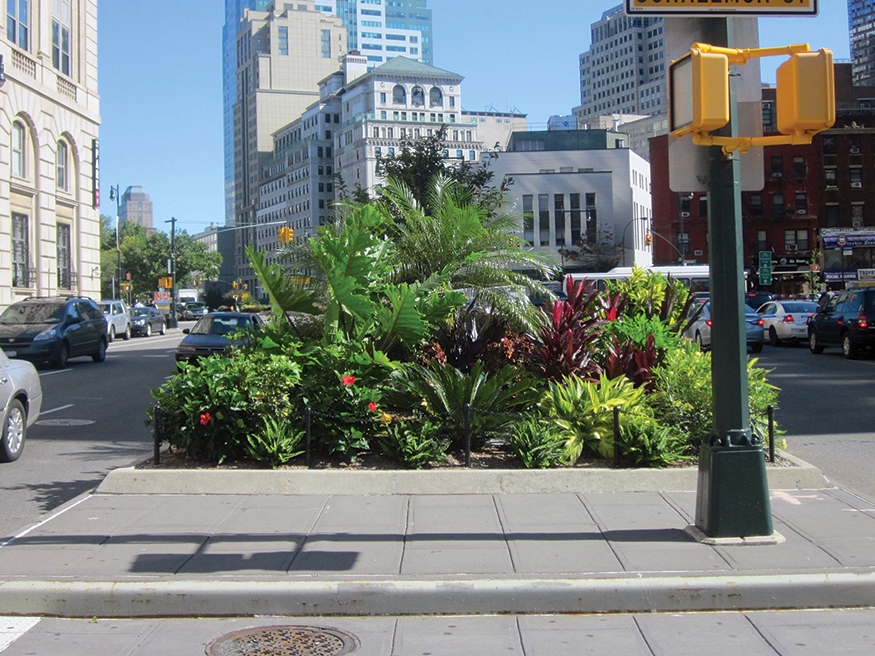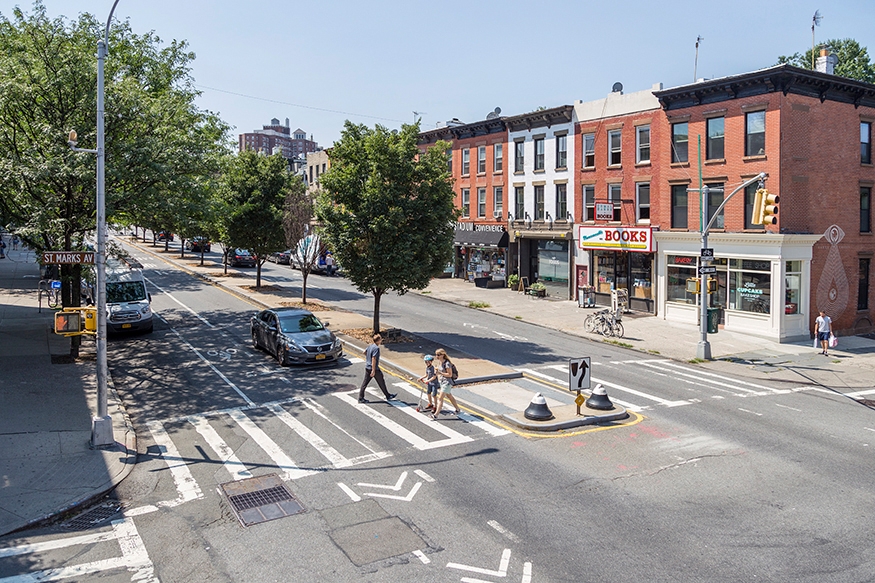A median that is raised 6 – 7 inches above the roadbed and provides adequate width to allow for plantings. Raised medians (curb height) are utilized throughout the city. Medians allow for various types of plantings due to their different sizes and lengths. Trees are typical; however, careful consideration must be given to the sight lines of drivers, cyclists, and pedestrians. Parks maintains many existing median plantings, pursuant to the Greenstreets agreement between Parks and DOT.


Benefits
See Benefits of Plantings in the ROW in the Introduction
- Planted medians increase the traffic calming effect afforded by medians. See Raised Median in the Geometry chapter
Considerations
- Allow adequate room for trucks and buses to make necessary turns without damaging plant material
- Consider environmental and physical stresses plants must withstand, including drought/inundation, sun/shade, heat/ cold, wind, pollution, road salt, garbage, vehicular damage, and compaction
- A 12-24-inch Raised Median is preferred in higher traffic areas in order to prevent vehicular incursion into planted areas
- Consider the lifespan and longevity of species, as plant replacement will be difficult and costly
- Typically, plantings are watered via a water truck; consider how maintenance workers will access the plantings to perform other regular maintenance activities; this may require a lane closure permit from DOT and should utilize appropriate safety equipment
- Consider underground utility constraints as excavation beneath the roadbed will be necessary to provide adequate soil volume and positive drainage; a 12-24-inch Raised Median may allow for plantings where there are conflicts
- Existing medians that are at least 12 feet in width, with curbs present, may be designed for stormwater capture if sufficient drainage can be diverted to the median and other general criteria are met; See Stormwater Management Practices
- Excluding trees, plantings in medians not covered under the Parks-DOT Greenstreets agreement or maintained by DOT require a maintenance agreement
Design
See Raised Median in the Geometry chapter for geometric design guidance; all medians must include a paved area, free of vegetation or obstructions, for pedestrians to safely cross at the intersection
See DOT’s Planted Raised Median Design Guidelines for further information
Where planting trees, see design guidance for Tree Bed
- Planted medians should be a minimum of 7–feet wide to allow for 6 feet of planting space with a 6-inch–wide curb on either side. Exceptions may be approved by DOT and Parks on a case-by-case basis. Where conditions allow, a buffer around the perimeter of the planting bed is preferred to allow for maintenance access
- Provide a minimum 24 inches depth of high-quality, well-draining soil; 30 – 36 inches is optimal – see Soils in General Guidelines
- Positive drainage below the planting soil is essential. Any impermeable layers of concrete or asphalt must be removed or appropriately designed weep holes must be included
- Where conditions allow, medians should be planted with large-growing canopy trees
- Tree spacing should be based on the appropriate mature width of the species chosen and must be approved by Parks
- Consider the use of a suspended pavement system and Connected Tree Beds
- Minimum distance from the curb at the end of the median to the center of the tree trunk is 35 feet
- Where truck and bus traffic is heavy, consider using columnar species to reduce damage to plants
- Consider planting fewer understory species to provide continuity and reduce overall maintenance needs; select plants that will provide year-round ornamental interest
- Space shrubs and other plants so as to encourage dense, full growth, and deter weeds, however, do not overcrowd, which can lead to poor air circulation and encourage the spread of pest and disease problems
- Use drought-tolerant, salt-tolerant species that require little to no pruning or deadheading to maintain their shape, size, vitality, and ornamental interest
Plants
See Plant Finder

